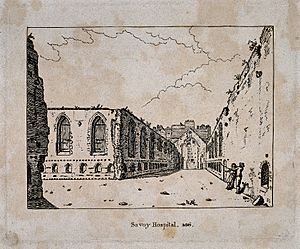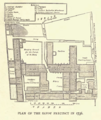Savoy Palace facts for kids
Quick facts for kids Savoy Palace |
|
|---|---|
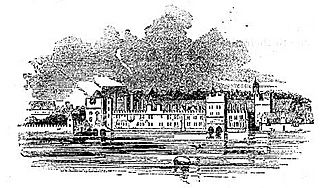
1848 engraving by Charles Thurston Thompson
|
|
| General information | |
| Type | townhouse |
| Architectural style | Norman |
| Location | Liberty of the Savoy, Middlesex |
| Country | England |
| Coordinates | 51°30′38″N 0°7′13″W / 51.51056°N 0.12028°W |
| Named for | Peter II, Count of Savoy |
| Destroyed | 1381 |
| Owner | Peter II, Count of Savoy Edmund Crouchback Thomas, 2nd Earl of Lancaster Henry, 3rd Earl of Lancaster Henry of Grosmont, 1st Duke of Lancaster John of Gaunt |
The Savoy Palace was once the most magnificent nobleman's home in medieval London. It was the main residence of John of Gaunt, a very powerful and rich man. Sadly, it was completely destroyed in 1381 during a major uprising called the Peasants' Revolt.
The palace got its name from Peter II, Count of Savoy, who was given the land in 1246. The property later came under the control of John of Gaunt's family. The palace stood between the Strand and the River Thames. Today, the Savoy Chapel, Savoy Theatre, and Savoy Hotel keep its name alive. The area around the palace even had its own special laws, separate from the rest of Middlesex.
Contents
The Grand Savoy Palace in Medieval London
In the Middle Ages, many rich nobles had homes in London. However, the best place to live was the Strand. This area was on the main road between the City of London and the Palace of Westminster. Westminster was where the king and parliament conducted their important business.
Living on the Strand had many advantages. Homes could have a beautiful view of the River Thames, which was like a major highway for boats. It was also far enough from the busy, smelly, and smoky parts of the City of London. This distance also protected homes from the constant threat of fires.
Who Owned the Savoy Palace?
In 1246, King Henry III gave the land for the palace to his wife's uncle, Peter II, Count of Savoy. Peter built a house there. This house later became the home of Edmund Crouchback, 1st Earl of Lancaster. His family, the Dukes of Lancaster, lived there for the next 100 years.
By the 14th century, the Strand was paved all the way to the Savoy. At this time, the palace was the huge riverside home of John of Gaunt. He was a younger son of King Edward III. He became a Duke of Lancaster through marriage. John of Gaunt was one of the most powerful people in England, second only to the king. He was also the richest man in the kingdom.
The Savoy Palace was known as the most magnificent noble house in all of England. It was famous for its amazing collection of tapestries, jewels, and other beautiful items. The famous writer Geoffrey Chaucer even started writing The Canterbury Tales while working at the Savoy Palace.
Why Was the Savoy Palace Destroyed?
In 1381, a big uprising called the Peasants' Revolt happened. It was led by Wat Tyler. The rioters blamed John of Gaunt for a new tax called the poll tax, which had caused the revolt.
Because of this, the rioters completely destroyed the Savoy Palace. They broke or burned everything inside. What they couldn't smash, they threw into the river. They even crushed valuable jewelry with hammers. It was said that if a rioter was caught keeping a silver cup for himself, his friends would kill him. Even after this destruction, the area kept the name Savoy.
The Savoy Hospital
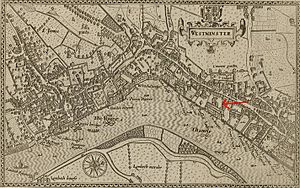
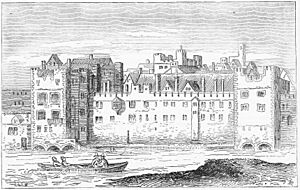
Years later, King Henry VII decided to build something new on the site. He founded the Savoy Hospital for poor and needy people. He left instructions for it in his will and gave it land.
In 1512, Henry VIII officially created the Hospital. It was a grand building, considered the most impressive hospital in England at the time. It was also the first to have full-time medical staff. The hospital had a large cross-shaped building for dormitories. Around it were a chapel, rooms for the Master and other officials, and a tower for safekeeping treasures and records.
Rules from 1523 explained the roles of different staff members, including a matron and twelve other women. Every evening, the staff would open the gates and let in the poor. They would pray in the chapel, then get a bed for the night. The matron's staff also made sure the men were bathed and their clothes washed. In the morning, everyone left, though sick people could stay and receive care.
Problems at the Hospital
From early on, the Hospital often had problems with how it was managed. An investigation into its operations took place in 1535. In 1553, King Edward VI closed the hospital. However, Queen Mary reopened it three years later.
In 1570, the Master, Thomas Thurland, was removed from his job. He had taken the hospital's treasures, sold its beds, and caused a large debt. After this, the hospital's luck declined. Some buildings were turned into homes for nobles, and later for tradespeople. During the English Civil War, it was used as a military hospital.
When Charles II became king, he tried to restore the Hospital. But in 1670, parts of it were again used by the military for soldiers wounded in the Dutch Wars. In 1679, the main dormitory and women's lodgings became barracks for soldiers. By this time, many tradespeople, like glove-makers and printers, had moved into the area. In 1695, Sir Christopher Wren built a military prison on part of the site.
Different Churches at the Savoy
In 1661, an important meeting called the Savoy Conference took place here. It led to different Protestant groups building chapels in the area. French Protestants used the 'Little Chapel'. German Lutherans used the former Sisters' Hall as a church. A German Calvinist Chapel and a Quaker Meeting House were also built.
A commission in 1702 found that the Hospital was no longer helping the poor. The Master's position was empty, and the remaining Chaplains were dismissed. The Hospital was officially closed.
Savoy Barracks
The Hospital buildings were used as military barracks for most of the 18th century. In 1776, a fire destroyed much of the structure. At that time, it housed a military hospital, prison, and recruiting office.
In 1775, Sir William Chambers was asked to design new barracks for 3,000 soldiers. He drew plans for a large, six-story building complex. However, these plans were never carried out. Between 1816 and 1820, almost all the remaining hospital buildings were torn down. This made way for the road leading to the new Waterloo Bridge.
Savoy Chapel
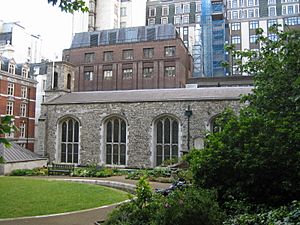
The only hospital building that survived the demolitions was its chapel. It is dedicated to St John the Baptist. It once hosted a German Lutheran church. Today, it is used by the Church of England as the church for the Duchy of Lancaster and Royal Victorian Order.
The Savoy Today
The name Savoy lives on in the Savoy Hotel and the Savoy Theatre, which now stand on the original site. Many nearby streets are also named after the Savoy, such as Savoy Buildings, Court, Hill, Place, Row, Street, and Way. Savoy Place is the London headquarters for the Institution of Engineering and Technology.
Images for kids
See also
 In Spanish: Palacio Savoy para niños
In Spanish: Palacio Savoy para niños


